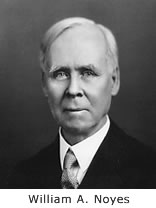William A. Noyes
William Albert Noyes (born November 6, 1857 in Independence , Iowa , † October 24, 1941 ) was an American chemist .
William Noyes studied at Grinnell College , graduated in 1879 with a bachelor's degree and then taught analytical chemistry there . From 1881 he studied at Johns Hopkins University , where he received his doctorate from Ira Remsen in 1882 ( On the oxidation of benzene with chromic acid ). His doctoral thesis also earned him a master’s degree from Grinnell College. To finance his studies, he also carried out chemical water analyzes. After completing his doctorate, he was an instructor at the University of Minnesota , a professor at the University of Tennessee and, from 1886, a professor at the Rose Polytechnic Institute (now the Rose-Hulman Institute of Technology ) in Terre Haute , Indiana . In 1903 he became the chief chemist of the US National Bureau of Standards (NBS) in Baltimore . There he acquired a reputation for very precisely determining atomic masses . For example, he determined the atomic mass ratio of hydrogen to oxygen to be 1.00787: 16. In 1907 he became a professor at the University of Illinois at Urbana-Champaign and head of the chemistry department. There he developed the chemistry faculty into one of the leading in the country and devoted himself primarily to organic chemistry , for example in determining the structure of camphor . In 1926 he retired.
From 1902 to 1917 he was editor of the Journal of the American Chemical Society and he founded Chemical Abstracts (later Chemical Abstracts Service (CAS)) in 1907 , of which he was first editor until 1910. In 1910 he was elected to the National Academy of Sciences and in 1913 to the American Academy of Arts and Sciences . In 1920 he succeeded William H. Nichols as President of the American Chemical Society . In 1924 he founded Chemical Reviews and was its first editor until 1926. After the First World War , he tried in vain to bring French and German chemists closer together.
In 1908 he and HCP Weber received the Nichols Medal for determining the atomic mass of chlorine. In 1935 he received the Priestley Medal and in 1919 the Willard Gibbs Medal . His son William Albert Noyes junior (1898–1980) from his first marriage (Noyes was married three times) was also a chemist and, like his father, received the Priestley and Gibbs Medal.
Web links
- Biography at the University of Illinois
- Literature by and about William A. Noyes in the WorldCat bibliographic database
| personal data | |
|---|---|
| SURNAME | Noyes, William A. |
| ALTERNATIVE NAMES | Noyes, William Albert |
| BRIEF DESCRIPTION | American chemist |
| DATE OF BIRTH | November 6, 1857 |
| PLACE OF BIRTH | near Independence , Iowa |
| DATE OF DEATH | October 24, 1941 |
